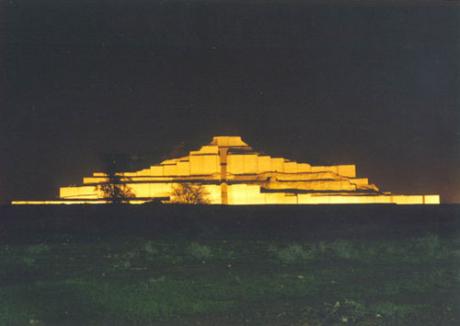
The Choghazanbil ziggurat (built by Dur-Untash) is the only surviving ziggurat in Iran and is one of the most important remnants of the Elamite civilization. The Elamite citizens were a nation who lived in Iran about 2500 years BCE and succeeded to announce their existence at Awan (now called Shoushtar, a town in Khouzestan Province). According to the chronicles of the Old Testament, an ancient king named Kedor Laomer in Elam succeeded to extend his domain as far as Palestine (Genesis, Chapter 14). The significance of the scientific and cultural achievements of Elamites and their influence on other civilizations can be better understood when we learn that the first wheeled pitcher (the first wheeled roller) was apparently invented by human beings at Elam. On the other hand the first arched roof and its covering which is a very important technique in architecture was invented by the Elamite and used in the mausoleum of Tepti-ahar around 1360 BCE (unearthed in the excavations made at Haft Tappeh) nearly 1,500 years before such arches were used by the Romans.
Choghazanbil is located in Khouzestan Province 30 km southwest of Shusha (Susa), the famous capital of Elam at a close distance from Dez river which is one of the branches of the large Karun river. This temple and the town bearing the same name has been built on a natural earth mound because of overlooking at the adjacent plains.
The old and original name of this town and its ziggurat was called Dur-Untash which according to the inscriptions discovered at the foundations of the ruined building in that town derived its name from Untash-Gal, the Elamite king (1275-1240 BCE) who was the founder of that town. This name has been repeatedly mentioned in Elamite and Assyrian inscriptions. The word `Dur’ in the Akkadian and Elamite languages means a town or an enclosed and distinct region. Ziggurat in Sumerian language means ascending to heaven and has its root in the Elamite word Zagratu.
In 1935, Brown, a New Zealand citizen who was seeking for traces of oil, while flying over that region was surprised to spot a huge earthen pile. In the same period, one of the geologists of the oil company had discovered an inscribed brick which referred to Choghazanbil and took it to the French archaeological team in Shusha. Thus the Iranian government permitted R. de Mecquenem, the representative of Louvre Museum in Paris and head of the French archaeological team in Shusa, to excavate the Choghazanbil area for a period of 5 years. De Mecquenem started his investigation and identification in the years 1936 to 1939, but the main excavation was commenced by R. Ghirshman in the year 1951.
Until 1962 Ghirshman succeeded to perform nine stages of consecutive excavations with 150 workers and in a period of 34 months he removed 200 thousand sq. meters of earth from the site by wagons and rail and succeeded to unearth the ziggurat from the depth of the earth.
According to the brick inscriptions in Choghazanbil, Ontash-Gal had built temples for nearly 19 Elamite and Babylonian gods. By collecting the local deities in the building, Untash-Gal converted it into an important religious site. This Elamite capital is very similar to Mecca before the advent of Islam in the Arabian Peninsula where different gods of various tribes were assembled. Untash-Gal built temples for Ishne-Karab, Kiririsha, Pinikir, Manzat, Inanna, Belit and Shiashum goddesses and gods like Napratep, Nabu, Humban, Sunkir Rishara and Kilah Supir and wedded deities such as Hishmitik and Ruhuratir, Shinmut and Inuru, Adad and Shala and Shushmushi and Beit at Choghazanbil.
One of the important ceremonies at Choghazanbil was to honor the god Shimit which was held on May 8 each year. In this ceremony known as the Tuga festival, a fat cow was sacrificed to the god. The Elamite used to observe another ceremony called Gushum held at the beginning of fall where a fattened sheep was sacrificed at the temples of Pinikir and Kirisha. Although a number of burnt human skeletons and bones have been discovered in the tombs in Choghazanbil, since this is the first proof of burning of human beings in Elam, one cannot be sure of such traditions in Elam.
The successors of Untash Gal transferred all the valuable relics of Choghazanbil to Shusa and gradually the town and ziggurat ceased their significance. Eventually in the eighth attack to Elam by Ashur Banipal, the Assyrian king, in the year 640 BCE this town was destroyed and abandoned for ever although traces of existence of Achaemenid and Parthian shepherds or later Iranian farmers have broken the silence of that ancient temple.
sources:
http://www.allempires.net/forum_posts.asp?TID=25395
http://www.choghazanbil.ir/persian/findex.htm
http://www.iran-daily.com/1384/2478/pdf/i12.pdf
http://www.cais-soas.com/CAIS/Archaeology/Elamaite/choghazanbil.htm






